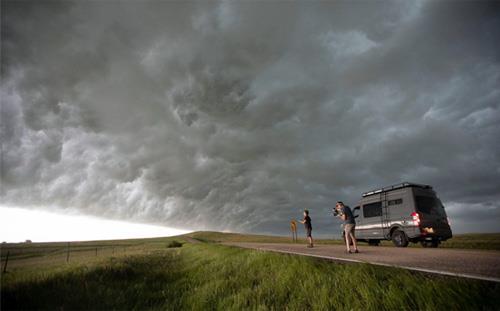
Storm chasing, it seems, just isn't fair. The storm never obeys borders; the chasers have to.
For Category 6 (top) – a new show filming storms for the National Geographic Channel – that problem comes with the pursuit of Tropical Storm Isiasis. The show is following it up the Atlantic coastline, producer Lisa Bloch told the Television Critics Association (TCA). But "come New Jersey, the storm (will) have to go on without us."
Blame COVID for that: Governor Murphy of New Jersey says people from 34 states and territories of the U.S. (at the time of this writing) must quarantine 14 days after entering New Jersey.
The storm, however, is free to zoom ahead, unpursued.
Such complications abound these days. As the TCA's virtual sessions with cable networks began Monday, the emphasis was on getting by. "We've gone from 4-to-8 person crews to one," Bloch said.
And a crew of any size still has trouble getting there. "The rules are changing so rapidly that we're often at the mercy of the gate-attendant," said Jon Kroll, producer of Gordon Ramsay: Uncharted.
For National Geographic, that gets especially complicated. When production temporarily halted on March 13, said network chief Courteney Monroe, the channel had people in a dozen countries, working on 77 different projects, planning 394 hours of television.
And yes, there might be some good coming from a pause.
Just ask Vanessa Berlowitz, producer of Queens, which films female-led animal communities. There were already plans to encourage media in other countries, she said. "This sort of accelerates our plan to use local filmmakers."
There's another benefit to a shutdown, said Anthony Hemingway, the Genius: Aretha producer. "Many of us were excited" by the break, "because it was so exhausting."
Now that break has stretched well beyond the welcome point.
The Aretha Franklin mini-series was expected to debut on Memorial Day weekend, but filming stopped after five of the eight episodes. There's still no plan for when shooting will resume.
That's a scripted show, which is the most difficult to do while social distancing. The non-fiction shows have tended to resume, but cautiously. "We shoot in relatively (remote) places anyway," Kroll said of Ramsay's series. "We think we're relatively safe."
Crews are smaller now – which has always been the case for Joel Sartore, working on a Photo Ark project to photograph every species. "The crew is usually me," he said.
Even in the wild, however, the concerns are there. Berlowitz said there are worries about passing COVID on to other creatures; it's difficult to "be socially distant from a monkey" who is curious.
But the channel pushes ahead, including projects that were filmed before the pandemic.
It's currently in its Sharkfest marathon with, Monroe said, ratings up 11 percent from last year. On Sunday (Aug. 9), the marathon moves over to the Nat Geo Wild channel – on the same day that Discovery launches its Shark Week – and the main channel moves on. It has upcoming projects: one produced by James Cameron (Akashinga: The Brave Ones, about an all-female anti-poaching army in Zimbabwe), and another directed by Ron Howard (Rebuilding Paradise, about a California town destroyed by wildfire).
And in November, the channel and the magazine plan a sweeping project: Virus Hunters will view the history and the future of pandemics, said Susan Goldberg, the National Geographic editor-in-chief. "This goes way back…. We totally should have been prepared for this. We knew it was coming."